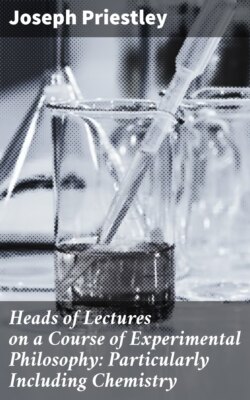Читать книгу Heads of Lectures on a Course of Experimental Philosophy: Particularly Including Chemistry - Joseph Priestley - Страница 6
Of the Properties of all Matter.
ОглавлениеBefore I consider the properties of particular substances, it will be proper to mention those which are common to them all. But I shall first observe, that the term substance has no proper idea annexed to it, but is merely a convenience in speech; since we cannot speak of the properties of substances, such as hard, round, coloured, &c. &c. (which circumstances alone affect our senses, and thereby give proper ideas) without saying that they inhere in, or belong to, some thing, substance, or substratum. The terms being and person are also in the same predicament.
One property of all substances is extension, since they all occupy some portion of space.
The incapacity of any substance to change its place has been termed, though improperly, the vis inertiæ of matter. It is sufficient to say, that neither this, nor any other effect can be produced without a cause.
Infinite divisibility is a necessary property of all extended substance; and from this circumstance it will follow, that the smallest quantity of solid matter may be made to fill the largest space, and yet none of the pores shall exceed the smallest given magnitude; and consequently, that, for any thing we know to the contrary, all the bodies in the universe may be comprized in the smallest space.
Another property usually ascribed to all matter is impenetrability, or the necessary exclusion of any substance from the place occupied by another. But the only proof of impenetrability is the resistance that we find to our endeavours to put one substance into the place of another; and it is demonstrated by experiments, that this resistance is not occasioned by the actual contact of the substances, but by a power of repulsion acting at a real distance from their surfaces. It requires a considerable force to bring two solid substances into as near contact as the particles of the same substance; and that these are not in actual contact is evident, from their being capable of being brought nearer by cold; and this is most remarkable with respect to the heaviest, that is, the densest, of all substances, viz. the metals.
A more positive argument for the penetrability of matter is, that the particles of light, after entering the densest transparent substance, do not appear to meet with any obstruction to their progress till they come to the opposite side.
The powers of attraction and repulsion seem to be common to all matter, and the component parts of all substances are kept in their places by the due balance of those opposite powers. If, by any means, the particles of any substance be removed beyond their sphere of mutual attraction, they repel one another, as those of water when it becomes steam.
Of the different kinds of attraction, that of gravitation seems to extend to the greatest possible distance; but that which keeps together the parts of the same substance, thence called the attraction of cohesion, and the different kinds of chemical attractions, called affinities, only act at a small distance. Of the causes of these attractions we are entirely ignorant.
